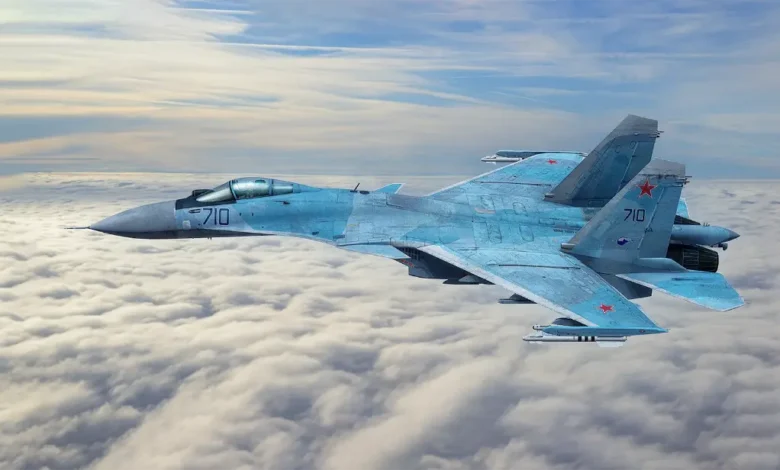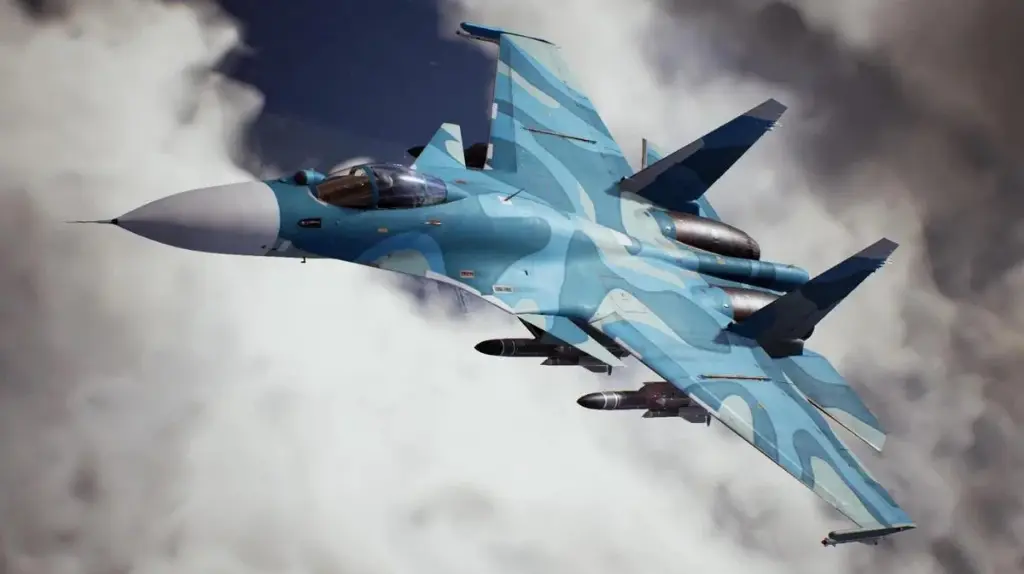Sukhoi Su-33

The Sukhoi Su-33, also known as “Flanker-D” by NATO, is a carrier-based multirole fighter developed by Sukhoi for the Russian Navy. First flown in 1987 and introduced in 1995, the Su-33 is a navalized variant of the Su-27, featuring folding wings, reinforced landing gear, and an arrestor hook for carrier operations. It is designed for air superiority, fleet defense, and ground-attack missions.
Fact Sheet
| Role | Carrier-based multirole fighter |
|---|---|
| Manufacturer | Sukhoi |
| First Flight | 1987 |
| Service Entry | 1995 |
| Crew | 1 |
Specifications
| Length | 21.2 m (69 ft 7 in) |
|---|---|
| Wingspan | 14.7 m (48 ft 3 in) |
| Height | 5.93 m (19 ft 5 in) |
| Empty Weight | 18,400 kg (40,565 lb) |
| Max Takeoff Weight | 33,000 kg (72,752 lb) |
| Powerplant | 2 × Saturn AL-31F turbofans |
| Thrust | 27,560 lbf (122.6 kN) per engine with afterburner |
| Max Speed | Mach 2.17 (2,300 km/h; 1,430 mph) |
| Service Ceiling | 17,000 m (55,800 ft) |
| Range | ~1,900 mi (3,000 km) combat radius |
| Rate of Climb | ~55,000 ft/min (280 m/s) |
Avionics & Armament
| Main Radar | N001 Myech radar |
|---|---|
| Avionics | Advanced avionics suite, electronic warfare systems |
| Armament | One 30-mm GSh-30-1 cannon (150 rounds); Up to 12 external hardpoints for: – Air-to-air missiles (R-27, R-73) – Air-to-ground munitions (Kh-31, bombs) – External fuel tanks |
Notable Features
- Carrier-capable with folding wings and arrestor hook.
- Multirole capability for air-to-air and air-to-ground missions.
- High maneuverability for superior dogfighting performance.
- Proven combat record in naval operations.
- Operated exclusively by the Russian Navy.

The Sukhoi Su-33 (NATO reporting name: Flanker-D) is a carrier-based, all-weather air superiority fighter designed by Sukhoi and manufactured by the Komsomolsk-on-Amur Aircraft Production Association (KnAAPO). It is a navalized derivative of the famous Su-27 “Flanker” and was initially known as the Su-27K during its development.
Development and Purpose
The Su-33’s genesis lies in the Soviet Union’s ambition to build large, conventional aircraft carriers and establish a robust carrier air wing. The land-based Su-27, with its excellent performance and maneuverability, was a natural starting point. However, adapting it for carrier operations required significant modifications:
- Reinforced Structure and Undercarriage: To withstand the immense stresses of catapult launches (though the Admiral Kuznetsov uses a ski-jump, not catapults) and arrested landings, the airframe and landing gear were substantially strengthened. It features a twin nose wheel for better stability during deck operations.
- Folding Wings and Stabilators: To maximize the number of aircraft that could be carried and to facilitate movement on a crowded carrier deck, the wings and horizontal stabilators (tailplanes) were designed to fold.
- Canards: The Su-33 was the first “Flanker” variant to incorporate canard foreplanes (small wings located forward of the main wings). These improve lift, especially at low speeds, reduce takeoff distance, and enhance maneuverability at high angles of attack – all crucial for carrier operations.
- Uprated Engines: While retaining the core AL-31F turbofan engines, they were adjusted to provide more thrust for short bursts, aiding in takeoff.
- In-flight Refueling Probe: Essential for extending range and endurance, particularly for naval operations.
- Arrester Hook: A tailhook for catching arrestor wires during landing on the carrier deck.
- Corrosion Resistance: Adapted for the harsh saltwater environment of naval operations.
The first prototype, designated Su-27K, made its maiden flight on August 17, 1987. The Su-33 officially entered service in August 1998 aboard Russia’s sole aircraft carrier, the Admiral Kuznetsov.
Key Features and Capabilities
The Su-33 is primarily designed for air superiority and fleet defense, inheriting much of the Su-27’s raw performance:
- Air-to-Air Combat: It is well-suited for intercepting enemy aircraft and defending the fleet. It carries a mix of R-27 (AA-10 Alamo) medium-range radar-guided missiles and R-73 (AA-11 Archer) short-range infrared-guided missiles on up to 12 hardpoints.
- Internal Cannon: It is armed with a 30mm GSh-30-1 cannon for close-range engagements.
- Avionics: The Su-33 features a modern (for its time) radar, an OEPS-27 electro-optical targeting system (IRST) for passive tracking, and an improved radar warning receiver (RWR). Its radar, the N001 “Slot Back,” has been noted for having less advanced multi-target tracking capabilities compared to more modern systems, often requiring reliance on AWACS for broader situational awareness.
- Limited Air-to-Ground Capability: While primarily an air superiority fighter, it has a secondary air-to-ground capability, capable of carrying unguided rockets and bombs. However, its precision strike capability is limited compared to dedicated multi-role fighters.
- Large Size: The Su-33 is a large and heavy aircraft, making it more challenging to operate from the comparatively small deck of the Admiral Kuznetsov compared to its smaller rival, the MiG-29K.
Operational History
The Su-33’s operational history has been closely tied to the fate of the Admiral Kuznetsov. Due to budget constraints following the collapse of the Soviet Union, only about 24 production aircraft were built.
- Russian Navy: The Su-33 has been the primary fixed-wing aircraft of the Russian Navy’s sole operational aircraft carrier, the Admiral Kuznetsov. It has conducted numerous training exercises and deployments.
- Combat Deployment to Syria: In late 2016, a detachment of Su-33s from the Admiral Kuznetsov was deployed to the Mediterranean for operations over Syria. They conducted some strike missions against ground targets, marking the Su-33’s first combat use. However, the deployment also highlighted challenges with carrier operations, with at least one Su-33 lost due to an arrested landing mishap.
- Limited Production and Obsolescence: The Su-33’s specific design for the Admiral Kuznetsov‘s ski-jump launch system and its limited multi-role capability, combined with the small number of carriers in the Russian Navy, led to a relatively small production run.
Operators and Future
- Russia (Russian Naval Aviation): The Russian Navy remains the primary (and effectively only) operator of the Su-33. However, with the Admiral Kuznetsov undergoing prolonged repairs and upgrades, and the Russian Navy’s shift towards the MiG-29K/KUB as its primary carrier-based fighter, the future of the Su-33 fleet is limited. The MiG-29K offers more modern avionics, full multi-role capability, and a smaller footprint, allowing more aircraft to be carried on the carrier.
- China: China acquired one Su-33 prototype from Ukraine and reverse-engineered it to develop its own carrier-based fighter, the Shenyang J-15 “Flying Shark.” The J-15 is a direct derivative of the Su-33, adapted for operation from China’s own aircraft carriers, which also utilize ski-jump launch systems.
While the Su-33 was a bold and impressive technical achievement, its operational life has been somewhat constrained by the limited number and readiness of Russian aircraft carriers. It stands as a testament to Russian aerospace engineering in adapting a powerful land-based fighter for the demanding environment of naval operations, but it is gradually being superseded by more modern and versatile designs like the MiG-29K and, for China, the J-15.



